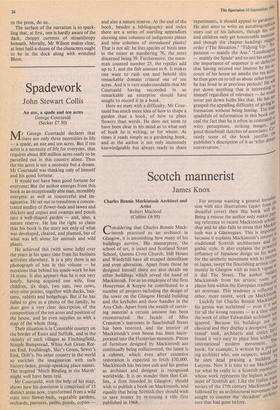Spadework
John Stewart Collis
An axe, a spade and ten acres George Courtauld (Secker £7.50) r George Courtauld declares that there are only three necessities in life — a spade, an axe and ten acres. But if ten acres is a necessity of life for everyone, that requires about 600 million acres ready to be parcelled out in this country alone. Thus the ten acres is not a necessity but a dream. Mr Courtauld was thinking only of himself and his good fortune.
It would not have been good fortune for everyone; But the author emerges from this book as an exceptionally able man, incredibly energetic as well as resourceful and im- aginative. He set out to transform a concen- trated medley of flower-beds and lawns and thickets and copses and swamps and ponds into a well-shaped garden — and, also, a nature reserve. He has the right to claim that his book is the story not only of what was developed, cleared, and planted, but of what was left alone for animals and wild plants.
He achieved this (with some help) over the years in his spare time from his business activities elsewhere. It is a pity there is no photograph of him in this volume — he mentions that behind his spade-work he has 14 stone. It also appears that he is not very lonely, having acquired one wife, four children, six dogs, two cats, two cows, sixty-nine ponies, together with ducks, ban- tams, rabbits and hedgehogs. But if he has failed to give us a photo of the family, he does give a very clear description of the composition of the ten acres and position of the house, and he even supplies us with a map of the whole thing.
Their situation is in Constable country on the border of Essex and Suffolk, and in the vicinity of such villages as Finchingfield, Steeple Bumpstead, White Ash Green Rot- ten End, Foulslough, Slut's Green, Sewer's End, Dolt's. No other country in the world so enriches the imagination with such history-laden, gossip-speaking place names. The inspired 'Much Binding in the Marsh' might well have been real.
Mr Courtauld, with the help of his map, shows how his dominion is comprised of 15 distinct areas now, transformed from a wild state into flower-beds, vegetable gardens, orchards, pastures, paths, ponds, copses — and also a nature reserve. At the end of the book, besides a bibliography and index there are a series of startling appendices showing nine columns of indigenous plants and nine columns of introduced plants! That is not all: he lists species of birds seen in the estate as numbering 76, the nests discerned being 39. Furthermore, the mam- mals counted number 23, the reptiles add up to 5, and the fish amount to 6. It makes one want to rush out and behold this remarkable domain created out of ten acres. And it is very understandable that Mr Courtauld having succeeded in so remarkable an enterprise should have sought to record it in a book. '
Here we meet with a difficulty. Mr Cour- tauld has much more idea of how to shape a garden than a book, of how to plant flowers than words. He does not seem to have been clear in his mind as to what sort of book he is writing, or for whom. At times it reads simply as a gardening book, and as the author is not only immensely knowledgeable but always ready to share
experiments, it should appeal to-gardene.rsi He also aims to write an autobiograpinq story out of his labours, though his woe, and children only get honourable mentl°,11; and though the chapter headings slag,' order (`The Situation.' Tidying up.' pansion — mainly the Axe.' Landscanolgi — mainly the Spade' and so on) his sense°, the importance of sequence is so defecty'e that having secured our interest by his ae: count of his house set amidst the ten acre': he then goes on to tell us about other house,,i he has lived in at previous periods! He WI put down anything that is interesting himself regardless of relevance — he vicalI1 never put down bulbs like that. He has Ir. grasped the appalling difficulty of giving formation without being boring. The hog" spadefuls of information in this book Of ceal the fact that he is often in command °d witty perceptions, striking images, !II, good thumbnail sketches of associates. (-ehre tainly some of the book justifies tul. publisher's description of it as 'after dinn` conversation.'






































 Previous page
Previous page